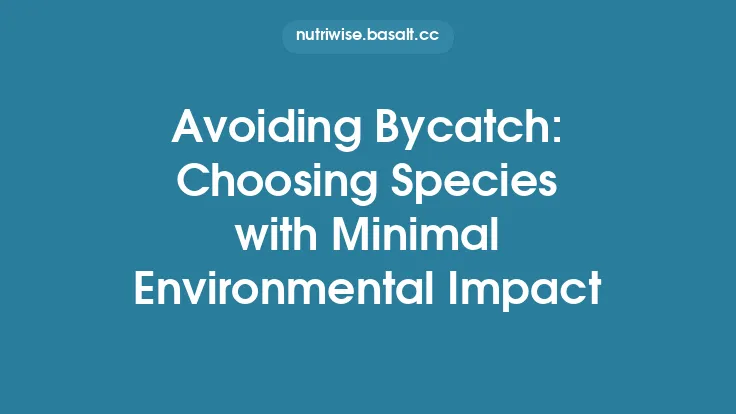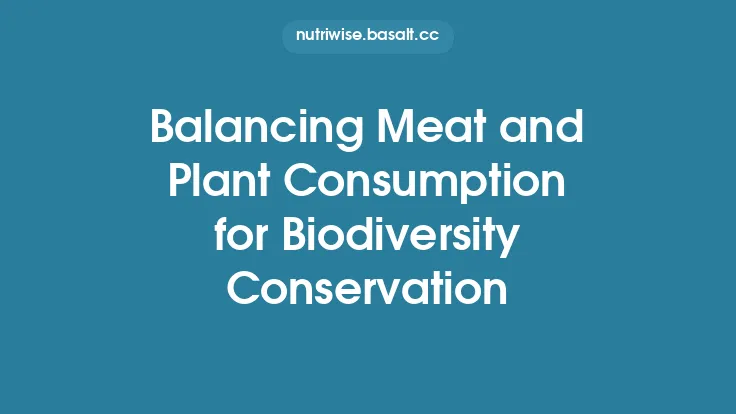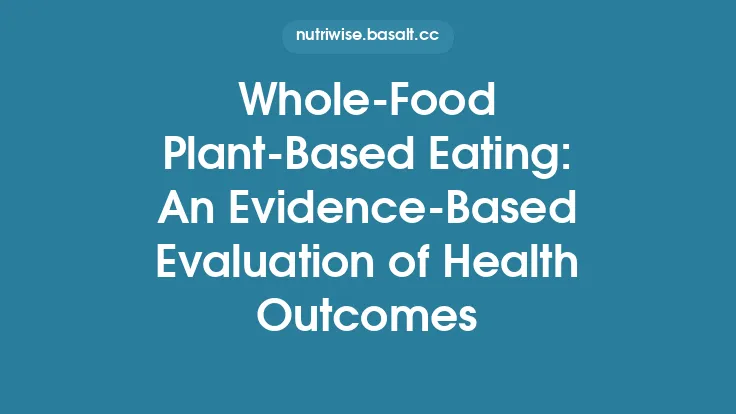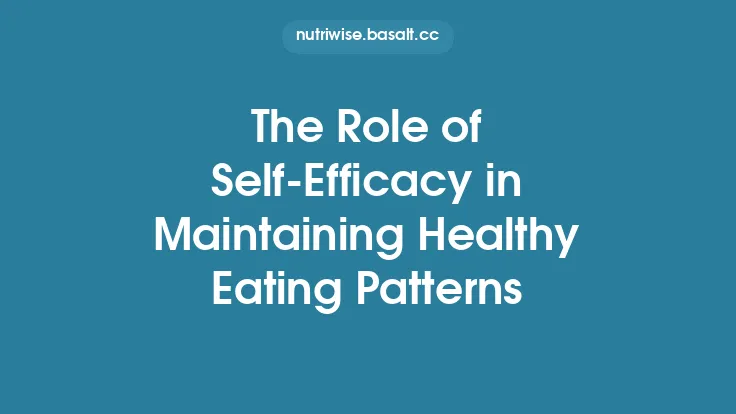Eating a wide range of species is more than a culinary adventure; it is a strategic lever for safeguarding the very habitats that wildlife depend on. When our plates reflect the planet’s taxonomic richness, the pressures that drive habitat loss, fragmentation, and degradation are distributed across a broader ecological canvas. This diffusion of demand lessens the intensity of exploitation on any single species or production system, curbing the cascade of land‑use changes that threaten forests, wetlands, grasslands, and other critical ecosystems. Below, we explore the mechanisms by which dietary breadth translates into tangible protection for wildlife habitats, and we outline actionable steps for consumers who wish to align their eating habits with habitat conservation.
Ecological Pressure and Species‑Specific Harvesting
Concentrated Demand Amplifies Habitat Stress
When a market fixates on a narrow set of food species—think a handful of staple grains or a few popular animal proteins—the production of those items expands to meet demand. This expansion often takes the form of monoculture fields, intensive livestock operations, or large‑scale fisheries that encroach on natural habitats. The ecological footprint of such concentrated production includes:
- Direct habitat conversion – forests cleared for soy, palm oil, or cattle pasture; wetlands drained for rice paddies.
- Indirect pressures – increased water extraction, fertilizer runoff, and pesticide use that degrade adjacent ecosystems.
- Trophic disruptions – overharvesting of a single fish species can alter predator–prey dynamics, affecting the broader marine food web.
Diversified Consumption Dilutes Impact
By spreading dietary demand across many plant and animal taxa, the need to intensify any one production system diminishes. For example, if consumers incorporate a variety of legumes, nuts, tubers, and lesser‑known fish species, the agricultural and fisheries sectors can allocate space and effort more evenly. This reduces the incentive to convert additional wild land for a single commodity, thereby preserving existing habitats.
Diversified Demand Mitigates Habitat Conversion
Land‑Use Efficiency Through Functional Complementarity
Different species thrive under distinct agronomic conditions. When farmers cultivate a mosaic of crops—cereals, pulses, oilseeds, root vegetables—each occupies a niche that matches its optimal soil, moisture, and climate requirements. This functional complementarity yields several habitat‑protective outcomes:
- Higher overall productivity per hectare – mixed cropping can achieve yields comparable to monocultures while using less land.
- Reduced need for expansion – efficient use of existing farmland lessens pressure to clear additional ecosystems.
- Enhanced soil health – diverse root structures improve organic matter retention, decreasing erosion that would otherwise degrade nearby habitats.
Livestock Systems Aligned with Landscape Heterogeneity
A varied animal‑protein diet (e.g., poultry, goat, rabbit, and small‑scale fish) encourages producers to adopt grazing and husbandry practices that fit local topography. Small ruminants can graze on marginal lands unsuitable for crops, while poultry can be integrated into agroforestry systems. These approaches maintain the integrity of native vegetation and prevent the homogenization of pastures that often leads to habitat loss.
Supporting Multi‑Functional Agroecosystems
Agroforestry and Silvopasture as Habitat Refuges
When dietary diversity drives demand for products that naturally fit into tree‑based systems—such as shade‑grown cacao, nuts, or certain leafy greens—farmers are incentivized to retain or plant trees within their fields. These trees provide:
- Structural complexity – essential for arboreal mammals, birds, and insects.
- Microclimatic buffering – moderating temperature extremes that benefit both crops and wildlife.
- Corridor creation – linking fragmented habitats across agricultural landscapes.
Polyculture Aquaculture and Wetland Conservation
A broad fish and shellfish palate encourages the development of polyculture aquaculture, where multiple species are raised together in the same water body. This practice mimics natural ecosystems, reduces disease pressure, and often utilizes existing wetlands rather than creating new ponds. By valuing wetlands for food production, their ecological functions—water filtration, flood mitigation, and habitat provision—are preserved.
Reducing Overexploitation Through Dietary Breadth
Fisheries Management Benefits
When consumers regularly include a spectrum of marine species—ranging from small pelagic fish to underutilized demersal species—the market pressure on any single stock eases. This diversification supports:
- Balanced harvest levels – allowing overfished stocks time to recover.
- By‑catch reduction – targeted fisheries for specific species can be designed to avoid non‑target organisms.
- Ecosystem‑based management – data on multiple species improve stock assessments and ecosystem modeling.
Wild Game and Sustainable Harvests
In regions where regulated hunting is part of cultural practice, a varied game diet can spread harvest pressure across several species, preventing the overharvest of a single ungulate or bird. Properly managed, this approach maintains population dynamics and the ecological roles each species fulfills within its habitat.
Economic Incentives for Habitat‑Friendly Production
Market Signals and Price Premiums
Consumers willing to pay a modest premium for less common species create a financial incentive for producers to maintain or restore habitats that support those species. For instance:
- Shade‑grown coffee or cacao commands higher prices, encouraging farmers to preserve canopy trees.
- Wild‑caught, sustainably managed fish often fetch better market rates, motivating adherence to quotas and habitat protection measures.
Diversification as Risk Management
From a producer’s perspective, cultivating a portfolio of species reduces vulnerability to pests, disease outbreaks, and market volatility. This risk mitigation encourages long‑term stewardship of land and water resources, as the cost of losing a habitat becomes a direct threat to multiple income streams.
Illustrative Case Studies
Mixed‑Crop Smallholder Farms in the Andes
In high‑altitude valleys, smallholders grow quinoa, amaranth, potatoes, and native legumes side by side. This polyculture reduces the need to clear additional páramo grasslands, preserving the unique water‑regulating ecosystem that supplies downstream communities and wildlife.
Integrated Silvopastoral Systems in Brazil’s Atlantic Forest
Farmers combine cattle grazing with native tree species and shade‑tolerant fruit trees. The resulting landscape supports a suite of forest‑dependent birds and mammals while providing diversified dairy, meat, and fruit products for local markets.
Multi‑Species Coastal Aquaculture in Southeast Asia
Communities cultivate milkfish, shrimp, and seaweed together in brackish ponds. The seaweed absorbs nutrients, improving water quality, while the varied species reduce the risk of total loss from disease, allowing the surrounding mangrove habitats to remain intact.
Practical Guidance for Consumers
- Explore Lesser‑Known Species – Seek out foods such as millet, teff, sorghum, jackfruit, or regional fish varieties at farmers’ markets or specialty stores.
- Prioritize Products Linked to Habitat‑Friendly Practices – Look for certifications that emphasize ecosystem stewardship (e.g., shade‑grown, sustainably harvested).
- Rotate Protein Sources – Alternate between poultry, eggs, fish, legumes, and responsibly sourced game to spread demand.
- Support Local and Seasonal Diversity – Seasonal eating naturally aligns with a broader range of species, reducing reliance on imported monocultures.
- Engage with Producers – Ask farmers or fishers about the habitats their products depend on and how they manage them. Consumer curiosity can drive transparency and better practices.
By consciously expanding the taxonomic breadth of our diets, we create a market environment that values ecological complexity. This, in turn, lessens the pressure to convert pristine habitats into uniform production zones, safeguards the intricate web of life that sustains wildlife, and contributes to a resilient, sustainable food system for future generations.





